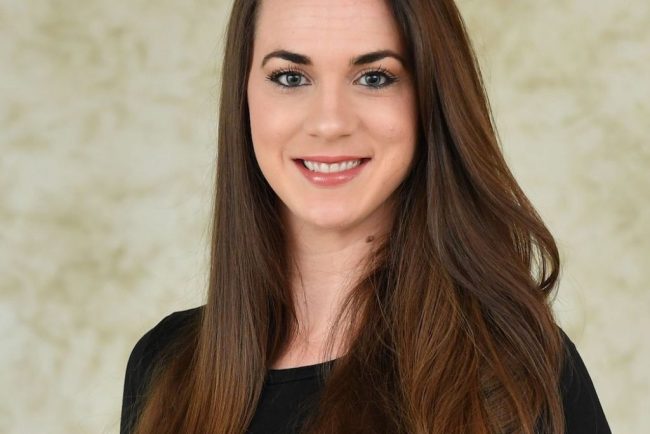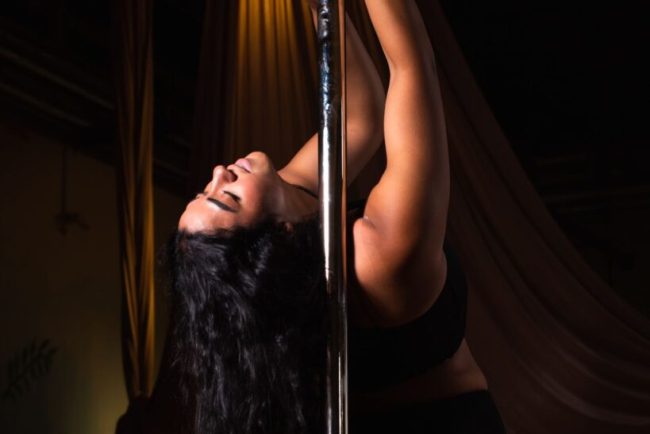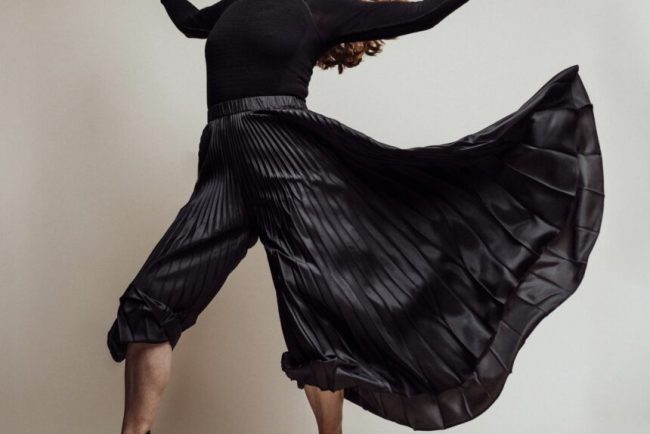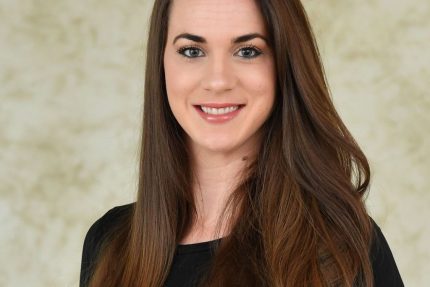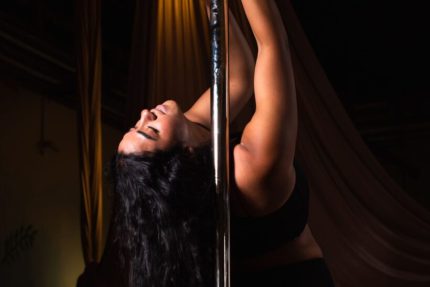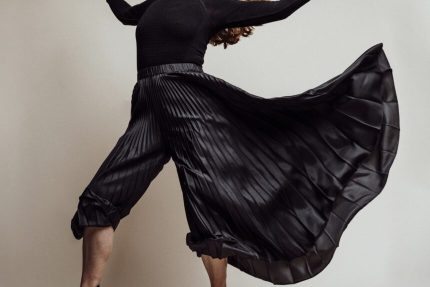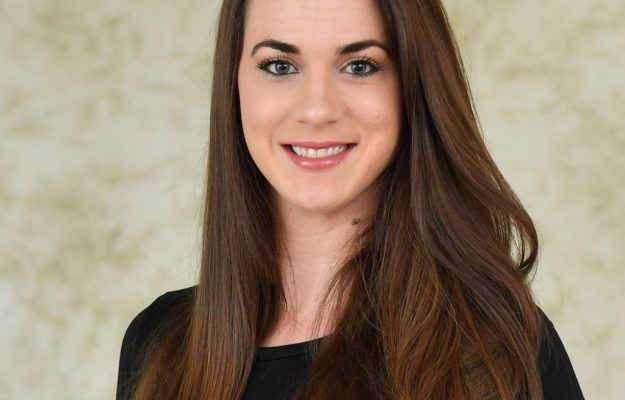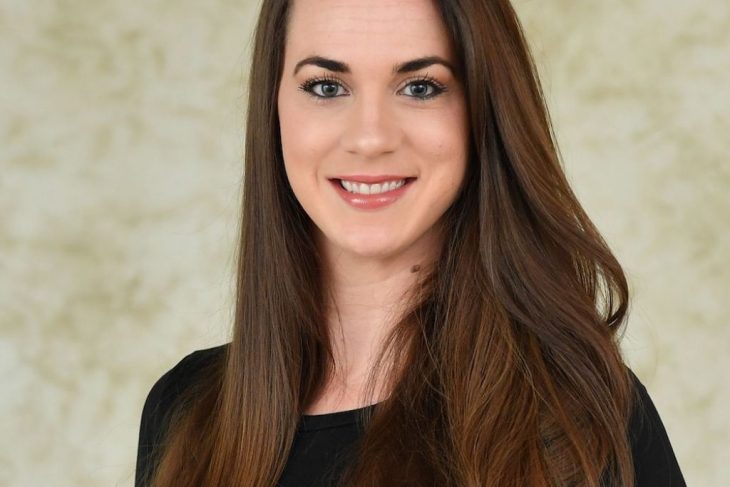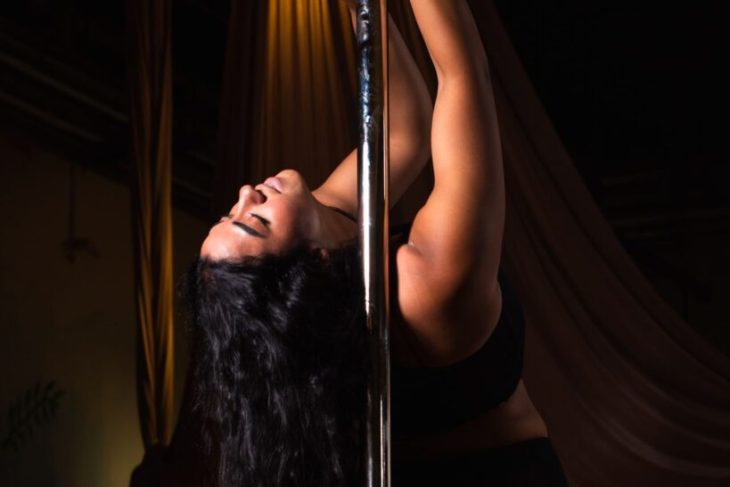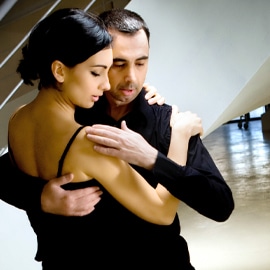
by Admin
10 Tips to Improve Your Ballroom Technique
Any ballroom dancer can tell you, there is no easy way to get amazing at any particular ballroom style in a short period of time. However, there are certainly best practices that smart dancers will use to ensure they get the most out of every […]
Ballroom dances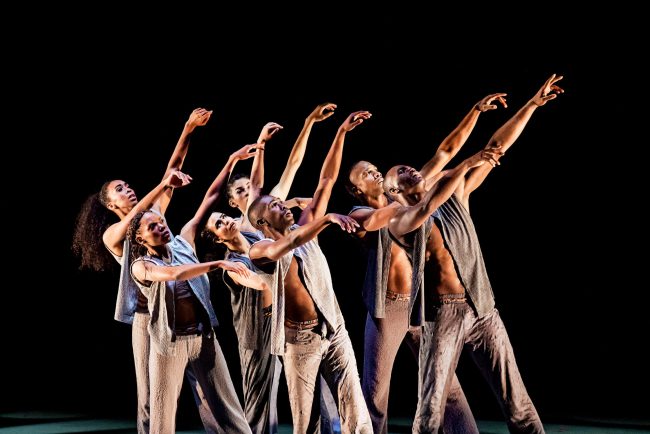
by Admin
How Dance Artists are Addressing the U.S. Prison System in Their Work, Both Onstage and on the Inside
For 22 years, dance artist Brianna Mims and her family have believed that her uncle Ronald Coleman Jr. was wrongfully convicted of involvement in a murder. Coleman has been serving two life sentences plus 65 years and is currently in Calhoun State Prison in Morgan, […]
Dance as activism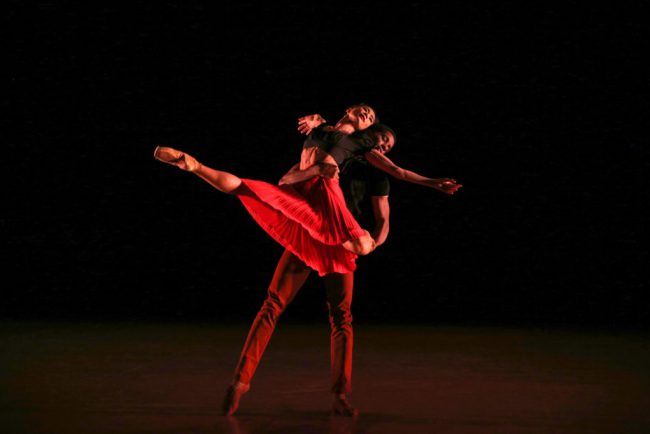
by Admin
Jennifer Archibald’s “Guess Who’s Coming to Dinner” Premieres at Richmond Ballet
Recent ballets by choreographer Jennifer Archibald explore how dancing creates a distinct kind of remembrance, homage and hopefulness. This week, her unique combination of choreography and documentary brings together political history, a cinematic classic and Richmond Ballet. Entitled Guess Who’s Coming to Dinner, her new ballet was […]
Dance as activism
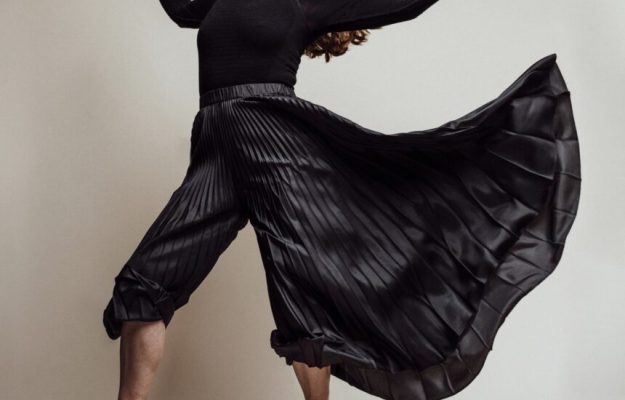
Gregory Richardson on Music From The Sole
by Admin
Despite having grooved onstage with tap icon Michelle Dorrance for over a decade, Gregory Richardson doesn’t consider himself a dancer. The composer and multi-instrumentalist is the musical director of Dorrance Dance and has been composing and performing with the company since its 2011 inception, having […]
ran-&-raveDespite having grooved onstage with tap icon Michelle Dorrance for over a decade, Gregory Richardson doesn’t consider himself a dancer. The composer and multi-instrumentalist is the musical director of Dorrance Dance and has been composing and performing with the company since its 2011 inception, having met Dorrance when they were both playing in the indie band Darwin Deez. In 2015, Richardson joined forces with Brazilian choreographer Leonardo Sandoval to create the Afro-Brazilian tap company and live band Music From The Sole, which was recently awarded a National Dance Project Production Grant from the New England Foundation for the Arts. With steady support from Jacob’s Pillow, The Yard and Works & Process at the Guggenheim—where Music From The Sole performed its third commissioned evening-length work in April—Richardson says he feels more confident than ever in what they are creating.
My main goal is usually to make sure the dancers and band are all one sonic force. If someone comes to a Music From The Sole show, they’re going to get right off the bat that the tap dance is the percussion of the song, and it’s not making it overly complicated. What we don’t want to look like is a dance company with a back-up band.
A unique part of our process is seeing how the musicians move. We do a lot of body percussion—slaps, claps and snaps—and give everyone movement to do together, so we embrace what the nondancers, including myself, add to it. We found out that our drummer is a fabulous mover and just naturally adds these little flourishes and hip movements. He’s extremely fun to watch, so we incorporated that. He’ll be spotlit in the next show.
We blur the lines when it comes to who is composing, too. There have been pieces where I wrote out a percussion part, recorded it, took it to Leo, and he choreographed the movement so the taps could replace the rhythm of the song. On another song, Leo came up with a melody, and I was able to notate, arrange and put chords behind it. That’s turned into this huge, beautiful piece. So, we’re both doing melodic and rhythmic work.
When you’re collaborating, you never get to use every single one of your ideas. But since Leo and I really get to have the final say, it’s the first time I’ve been able to stake out certain priorities that I simply don’t sacrifice. It’s a lot of pressure, but it’s also a lot of fun.
I’ve learned to trade drafts often. If you rehearse the band and dancers separately and things evolve, you can start to get on different pages. You can be totally enamored with what you’ve made, but when you come back together, it’s dissonant and someone has to give up more than they’d like. As soon as I’m excited about something, I show it to Leo right away.
Traditionally, a musical director makes sure the music is being executed right, runs the rehearsals and takes care of personnel issues with the band. But Michelle is such a killer musician, dancer and percussionist, she’s at the helm in a full rehearsal with Dorrance Dance, stopping the musicians to adjust tempo or dynamics. She has a vision for what she wants the whole show to be—and good instincts—and that just makes my job easier.
Michelle has definitely been my model for growing and leading a company with integrity. Like when you go into a new venue, introduce yourself to everyone from the front-of-house manager and sound engineer to the lighting assistant. Bring them in like they’re your team, and they’ll be excited to help execute your vision. And when someone gives you an opportunity, you better wring it for every drop it’s worth. If they give you a week of residency time, you better be in there for 10 hours a day.
The post Gregory Richardson on Music From The Sole appeared first on Dance Magazine.

by Admin
How Intimacy Consultant Anisa Tejpar Coaches Sensitive Dance Scenes
From Manon’s bedroom pas de deux to Sonya Tayeh’s entwined ensembles in Moulin Rouge! The Musical, intimacy is everywhere in dance. It’s also sensitive territory, and some companies are turning to intimacy professionals for guidance. During its recent production of John Neumeier’s A Streetcar Named Desire, which […]
ran-&-raveFrom Manon’s bedroom pas de deux to Sonya Tayeh’s entwined ensembles in Moulin Rouge! The Musical, intimacy is everywhere in dance. It’s also sensitive territory, and some companies are turning to intimacy professionals for guidance. During its recent production of John Neumeier’s A Streetcar Named Desire, which addresses interpersonal violence, mental health issues, sexual orientation and consent through intensely physical choreography, the National Ballet of Canada engaged intimacy consultant Anisa Tejpar. A former dancer with ProArteDanza in Toronto and a rehearsal director with Côté Danse, Tejpar spoke with Dance Magazine about how she helps dancers feel safe while staying true to the choreographer’s vision.
Starting the Conversation
It was as if Tennessee Williams had an intimacy professional in mind when he wrote scenes depicting sexual assault, mental illness, suicide, homophobia, sexual physicality and plain nastiness. Simulated sex, nudity and aggression in performance have to be processed through today’s much-needed requirement of consent. Dance historically has been last at the table in these conversations and yet is the most physically and emotionally charged of the performing arts.
Creating Safe Spaces
The challenge was to help each artist make the provocative material work for them within their own boundaries. Give them space to vent, dialogue, question and make the choreography their own and something they consented to…the antithesis of what the play is all about.
Defining Consent
For the performer, the questions are personal. How do we show consent in an onstage kiss that is meant to be consensual, when there are no lines? Consent matters, and today’s performance environment requires sensitivity and recognition of the performer’s individuality and boundaries.
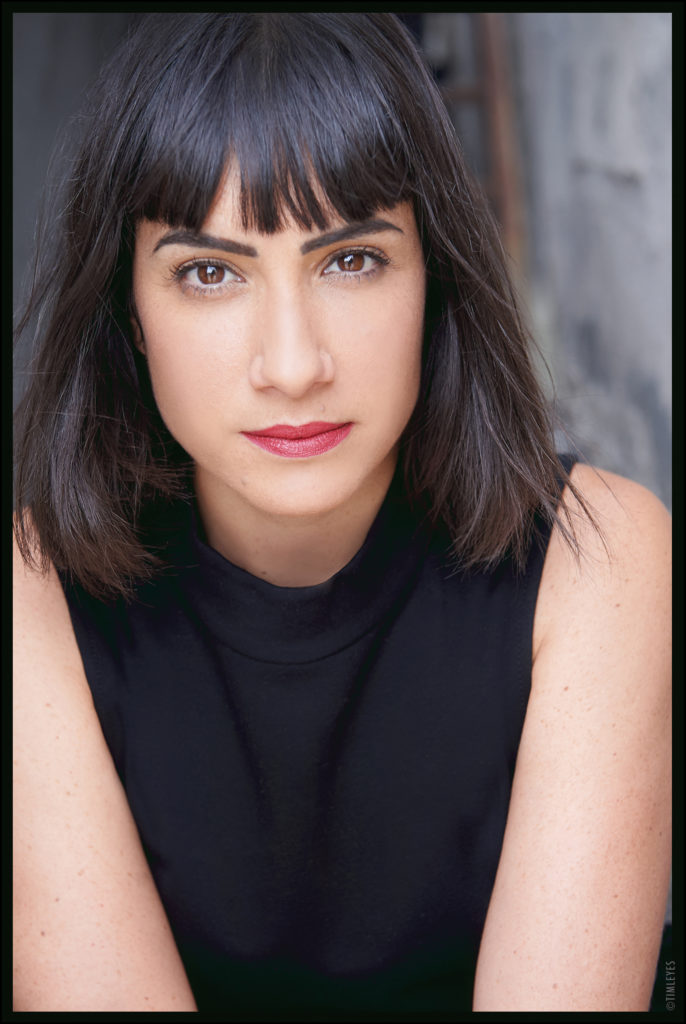
It’s About the Audience, Too
My lens also filters care for the bystanders in the studio or onstage who watch, listen and are affected emotionally by the weighted acts being performed by their colleagues. I created content warnings for the program and website to mitigate unwanted surprise in the theater.
Respecting Confidentiality
NBoC participated fully and created a collaborative environment for all players in the production. In this groundbreaking approach, I was mandated to have confidential conversations with artists throughout the process and performances, and communicate concerns up the chain.
A Growing Effort
An intimacy professional is invaluable to new creations and remounted works with challenging themes. Scottish Ballet recently hired intimacy coaches for their adaptation of Sir Kenneth MacMillan’s Mayerling, and Rambert engaged Yarit Dor as an intimacy director for Rooms in 2021.
Moving Art Forward
This is a new, exciting and powerful time for performance. A time where voices can be heard, where an individual’s boundaries become a creator’s opportunity, and where those of us who have a passion for storytelling and onstage magic can support artmaking in a way that protects and nurtures performers as they reach new heights.
The post How Intimacy Consultant Anisa Tejpar Coaches Sensitive Dance Scenes appeared first on Dance Magazine.

by Admin
Karole Armitage’s Diary of “A Pandemic Notebook”
Taking class with Baryshnikov in the room never fazed me. It was the late 1990s and I was in college in Manhattan, where I took (and still take) classes at Steps on Broadway, and where Baryshnikov or any number of dance superstars might roll in. […]
ran-&-raveTaking class with Baryshnikov in the room never fazed me.
It was the late 1990s and I was in college in Manhattan, where I took (and still take) classes at Steps on Broadway, and where Baryshnikov or any number of dance superstars might roll in. It’s not as though he wasn’t incredible; that’s a given! But when Karole Armitage showed up for Simon Dow’s class one day, taking her place at the barre along the Broadway-facing windows in Studio 2, with her signature spiky platinum pixie cut and wearing a pair of red sweatpants, I paid attention. She was already a legend in my mind—she had danced with Ballet du Grand Théâtre de Genève in the mid-1970s before switching gears and returning to New York City to join the Merce Cunningham Dance Company for five years. Her own choreographic debut in 1979—costumed in fur pants and performed in a high school gym—garnered her the nickname “Punk Ballerina.” And although she’d been directing and choreographing prolifically for some of the most prestigious dance and opera companies in Europe since the mid-’80s, she’d come back to the city to test the waters—not long after we first overlapped in class, she established the latest incarnation of her own company, Armitage Gone! Dance (AG!D), in New York.
Soon after that chance encounter at the barre, I holed up at the New York Public Library for the Performing Arts to catch up on her riveting early performances on grainy black-and-white videos. The founding members of the new company, and those who came after, were quiet riots, pulsing with rich interiority and laser-cut technique. As a child, Armitage split her time between the small university town of Lawrence, Kansas, and the wilderness of Colorado. And yet her directorial aesthetic so clearly reflected the energetic urbanity and diversity of New York City, as it still does today. Her movement vocabulary is at once calligraphic and off-kilter, formalist and influenced by street dance and pop culture. Armitage’s restless intellect propels the work to unexpected, unconventional places, but with the integrity and undergirding of rigorous research. The nonnarrative choreography is often rooted in art, fashion and science, as in her 2008 collaboration with theoretical physicist Brian Greene about string theory, in which I danced as a guest performer.
Although 2021 was the first year since its inception that her company didn’t perform live, it soon became clear that she was still hard at work. Early in 2022, I started seeing publicity materials for the New York AG!D season in March, which included such foreshadowings as “Karole’s first performance since 1989, likely her last” and “the final season of new work.” A turning point was at hand. As a fan of this insatiably curious iconoclast whose artistic journey presaged aspects of my own, I invited Armitage to shed some light on her inner workings in the weeks leading up to the performances of A Pandemic Notebook. The twist was that I asked her to keep a diary rather than participate in an interview. I offered her the proverbial mic. While she confessed to never having done anything like it before, she was game. What she has shared is a window into the logistics of putting on a performance, the wisdom gained through hard experience, and questions about what her future holds. I’m thrilled, but hardly surprised, to say that her incisive writing voice is every bit as compelling as her choreographic voice.
2.22.22
The date is auspicious. 2.22.22. Maybe this way I can get myself to start a diary. I’ll begin with quotes to explain why a diary is just not my thing.
As Joan Didion once wrote, “Our notebooks give us away, for however dutifully we record what we see around us, the common denominator of all we see is always, transparently, shamelessly, the implacable ‘I.’”
Author Helen Garner, who burned her notebooks, wrote in The Guardian in 2019, “I was so bored with my younger self and her drowning sentimental concerns that there was nothing for it—this [expletive] had to go.”
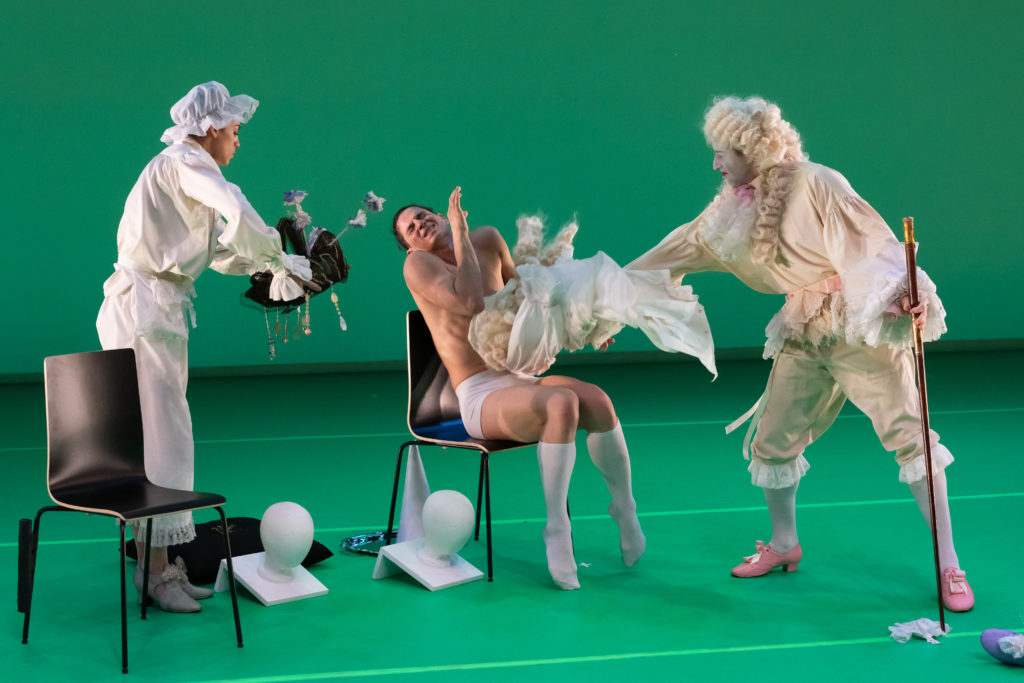
2.23.22
What do you do when someone in the subway asks you for money? My philosophy is to give to anyone who asks, because, as I see it, if someone is in the subway asking for money, they must need it. I keep dollar bills for that purpose. And on the subject of money, I finally faced up to buying enough COVID tests so that everyone can do a daily rapid test prior to rehearsals. The bill for the season is about $2,500. That’s hard to swallow, but it feels good to see negative tests line up as each dancer and our company class teachers send in the results. We always start the day with ballet class and then rehearse for six hours. We also spent a lot of money this year going into three dance bubbles, in order to create the work for our March season at New York Live Arts. A five-second commute is a nice feature of a bubble, as well as a company dinner. I invited some wonderful Italian friends of mine to become cooks for us daily. There’s nothing like having Italian food prepared by a real Italian unleashing the genius of Italian cuisine.
2.24.22
I read with interest that Mark Morris goes to the studio three times a week these days. Beato lui [“lucky him”]. That’s as far from my life as imaginable.
2.25.22
We’ve had fantastic classes this past week from former NYCB dancer Antonia Franceschi. I’m thrilled to see that she, like Paul Boos, who’s also one of our regular teachers and a former City Ballet dancer, has the willpower and knowledge to demand the highest level of aspiration from us in mind and body. This means aiming to master the technology of the body, and the musicality of that technology, while unleashing one’s personal imagination. That’s how I was raised and that’s what I believe in. I’ve had unwavering willpower in aiming for that over all these years. This rigor applies to all of it, from dance classes, to costume and lighting design, to the choice of music, to treating dancers and collaborators well. I believe in working only if I can provide a living wage in the form of a serious salary and planning every detail, so that everyone knows what to expect. But lately, I feel exhausted by these aspirations. There are so few who care about these things and keep the faith. There are so few who believe that in the silence of dance, that in pure movement, we can grapple with existential and spiritual questions, finding solace and connection.
2.28.22
Today we have a costume fitting with a wonderful artist and our wardrobe manager, Aaron Cobbett. The dress for our dance Beautiful Monster is based on the fabulous dress that Silvana Mangano wore in the Italian film La Strega Bruciata Viva, by Luchino Visconti. It was made by a great seamstress who teaches tailoring at a well-known university. However, something with the dress went completely awry. It hangs on dancer Sierra French’s body in a way that is pinched and corseted, particularly egregious given that the fabric is very stretchy. I spent hours and hours ripping it apart and resewing it by hand. But it is still lousy. It’s interesting how people can get an idée fixe in their head and not see reality. I learned long ago that what I felt while dancing or choreographing was not objective. I learned to mistrust myself. One must let go of one’s ideas and, with a very cool eye, examine the result.
“Rats and roaches live by competition under the law of supply and demand; it is the privilege of human beings to live under the laws of justice and mercy.” Wendell Berry

3.1.22
Yikes, it’s March. Two weeks till showtime.
It seems like costumes never get done. It’s so hard to find the simplest things, like socks that fit right, or socks with mainly cotton fiber, so they’re not slippery. Thanks to Amazon, all the old standby stores have gone out of business. Ugh! Not to mention the harm to the environment in fuel use and throwaway packaging. What does the Amazon phenomenon have in common with small dance companies? The biggest thrive and the smallest disappear. It’s pretty insane that dance companies with a $500,000 budget are competing with the dance companies that have a $25 million budget for precisely the same resources—the same very small pool of New York City patrons for dance, the same granting agencies and even the same studio space. I’ll never forget being thrown out of a studio a few years ago when a major ballet company needed extra rehearsal space for one of their special programs. Even though I had paid two months in advance, we were kicked out.
Although all of the dances we are presenting live have been filmed, one would think that means that the costumes are finished, but that isn’t the case. There are so many costume elements that must be adapted for quick changes. Snaps, Velcro, new rigging and myriad other extra bits to make things faster. Every second backstage counts.
3.2.22
A lot of challenges with the technology today. First it was the JetBlue website not working. But then it escalated into almost everything seeming to be hard to do. The most important is for the dance 6 Ft. Apart. The sound is generated by accelerometers taped onto bodies to create a soundscape in real time. I was having trouble with the coding, but that got solved thanks to the genius of sound engineer Agnes Cameron, who guided me via screen share from London. Now, for some reason, the feather that is part of the equipment isn’t communicating with accelerometers to respond to momentum. More to untangle. The more I work with hardware and software that isn’t human, the more I appreciate the extraordinary technology of the human body. Dancers are a trillion times more reliable than all the other stuff.
3.4.22
What will today bring? Worries about technology continue. Should I buy seed pods that we could mic as a backup, in case the receiver and accelerometer system does not fire up?
Apparently, The New York Times plans to review the show, which brings forth a dark dread. There is consistently a gargantuan gap between those reporters’ perceptions and mine.
3.6.22
Jock Sotohttps://en.wikipedia.org/wiki/Jock_Soto arrived in New York from his home in Eagle Nest, New Mexico. We had a great rehearsal. We made minor adaptations to make the dance work on the stage, rather than in the wilderness landscapes where the work originated. Frankly, it’s a lot easier to dance on marley than on snow, sand, lava and rock.

3.20.22
I forgot to write during the entire week we were at the theater for tech and performance. It’s always very intense when preparing and rehearsing for a season, given the requirements of fundraising, administration, publicity and marketing, logistics and the art itself. Last week, though, everything outside of the theater flew out of my brain.
So, to recap: As expected, I was preoccupied with the complicated jobs outside of my own dancing—lighting, projections, sound and new staging. There are always surprises. During tech, the Baroque wigs for Louis shed bobby pins dead center stage. How to deal with that? We came up with an amusing solution: Alonso Guzman, wearing the accelerometers, came out to center stage carrying a broom and dustpan and proceeded to do a violent shimmy, setting off cascades of sound while sweeping, a fairly comic and bizarrely existential moment.
As for my own dancing, I had one really great night out of four. The core company members, Sierra French, Alonso Guzman and Cristian Laverde-Koenig, were magnificent every night, as were the newer members, Isaac Kerr, Kali Oliver and Kara Walsh. There was only one day that I had no insanely stressful, urgent problems that had to be dealt with. On Friday, I could calmly take class, rehearse, warm up right before the show and then perform. I could feel the magic of playing with time and consciousness. That is the great gift of live performance, for both performer and audience.
I always kept in shape, at least vaguely. My body is my sketchpad. I’m generally dancing all day, every day, at a low technical level, to practice choreography. For 25 years, however, I stopped taking class in order to let some of my mild injuries heal. I did intense yoga and Pilates to realign. But this season I had to go back to ballet. Like an 8-year-old child, I worked like a fiend at the basics—placement and turnout—trying to acquire strength once again, so that at age 68, I could dance with some dignity. It worked out pretty well. My circle of dance life became complete. My first professional job was dancing in all-Balanchine repertoire in the company Mr. B directed in Geneva, Switzerland, at the Grand Théâtre de Genève in the ’70s. Though he wasn’t there all year long, he taught us class, staged the ballets, worked with the orchestra on colors and tempo, and took the “girls” (as we were called then) out to dinner for fondue. My circle became complete by dancing with Jock Soto, who very generously lent his years of experience as a principal dancer at New York City Ballet to our cause and was my partner last week during our season. Thank you, Jock!

On the night of our last show, March 19, the craziest thing happened. The electric grid was struck by lightning. All power failed, except for one computer controlling the stage lights. The other computers, lights, fans, backstage lights, monitors, the projector and the sound went out. Luckily the sound came back pretty quickly. But nothing could get the projector going again. I had to improvise two spoken interventions to cover the time needed for costume changes so that we could finish the show.
At least half of the audience stayed in the lobby every night to cheer us on. Everyone loved the show, except some of the press, as expected. I do things that are new and different, that challenge dance culture and that aren’t yet accepted. I’m used to bad reviews because I was the first person to put a man in a skirt onstage as a matter of style and identity rather than drag, the first person to deeply entwine the technique and sensibility of modern dance with ballet and street influences. I worked in film, on Broadway and with pop stars, when doing anything outside of strict theater dance was taboo. I paved the way for others.
The lightning strike on the building also struck my brain. Self-producing is a no-win game.
Self-producing is the only option if one wants to maintain a company by having an annual season, because the very few institutions that commission or present dance in New York City are not in a position to present a company annually. Without institutional support there’s no way to reach an audience, get funding, get previews in the press, get into the cultural priorities of the moment, et cetera. The season we just finished encompasses 2.5 years of mostly very intense work and hundreds of thousands of dollars in expenses.
The difficulties are not just financial. Working with freelance collaborators means that the cherished minds you hope to continue to work with aren’t available and you have to spend weeks, if not months, finding a way to replace them. You perform for four nights and many who want to see it are out of town. There’s no way to actually get the message out that the performances are taking place. Our internet society is diffuse and without authority. Thus, there’s the great challenge of finding an audience, exacerbated by on-demand culture, the disappearance of representation in dance, a staid and unadventurous mindset in the dance world and continuing pandemic paranoia. We had a roughly 35 percent absentee rate in people not showing up who’d purchased tickets. I’m very grateful to everyone who bought tickets, to those who came, and am especially gratified by the unbridled enthusiasm that greeted us nightly.
Everything about self-producing is punishing, except for working with the dancers and communicating with an audience. That is exhilarating. I’ve done it, against all odds, since 1981, when I quit the Cunningham company. Self-producing means leading a life so perverse and out of balance that I just might not be able to face the preposterousness of it anymore, mainly because everything has become that much harder every year.
That would mean essentially letting go of my company now, and that is very hard. I’ve had an extraordinary group of dancers. Those who made up the relaunching of the company in 2004 when I returned from 15 years abroad, until today—yes, nearly 20 years—have been incredibly gifted dancers both creative and technically remarkable, as well as generous and thoughtful human beings. I am at peace with letting go, though it is not my desire. It seems like it is time to swerve, but in what direction I do not know.
I had a fulfilling end to my dance and choreographic life in New York City with this last season. We demonstrated resolve and resilience through the terrible challenge of COVID. I was able to pursue a rewarding experience as both a dancer and a choreographer, and even as a filmmaker. I will continue to work in opera, in film and live with dancers, if and when we’re commissioned to create. Our next project is a site-specific work for the James Turrell installation Twilight Epiphany, on the Rice University campus in Houston on April 22 and 23. Ciao! Enjoy life! Fight for what you believe in.
The post Karole Armitage’s Diary of “A Pandemic Notebook” appeared first on Dance Magazine.

by Admin
Reconsidering the Relationship Between Social Media and Creative Practice
When I was little, I would people watch all the time. I would narrate what I thought they were thinking and doing. I would do accents. That sense of wonder and play and whimsy is essential to my work. Those moments alone or with friends […]
ran-&-raveWhen I was little, I would people watch all the time. I would narrate what I thought they were thinking and doing. I would do accents. That sense of wonder and play and whimsy is essential to my work. Those moments alone or with friends when you’re playing around, you go a little too far and you say, “That should be in a piece.” Lately, I’ve been giving my mind an opportunity to experience that and wander again.
It started in 2020, when I felt free to do something I had wanted to do for a long time: disengage online. I thought, If the reason I came to social media was to promote my company, there’s no reason to do that, because right now there’s no work. Everything I had was canceled. So I took a four-month social media hiatus starting in August 2020. In 2021 I deleted Instagram and Facebook from my phone. I could still post from my computer. My latest break, which started in November, has been about trying to reimagine my relationship to social media in a way that’s healthier. And professionally, in researching my work, I’m trying to be conscious of this intimate relationship.

What I had noticed is that I was disassociating from the world. I wasn’t engaging in social media in a meaningful or sincere way. It was like a bad relationship. Social media and I were just passing the time together rather than finding a deeper intimacy.
I also noticed I never had an opportunity for my mind to wander, which is important to me creatively. That felt so sad. Whenever there was a quiet space, there was my phone. I need a couch for a piece—go to my phone. Haven’t talked to a friend in forever—go to my phone. Instead of calling her, my instinct was always to reach for social media. And when that wasn’t possible, I would think, Wow, who do I talk to?
“I’ll have this profound moment in rehearsal and think, I need to post this so people can see it. That’s bizarre.”
Rosie Herrera
I wondered, What are the questions, the answers, the fears I am asking social media to solve? Every time I’m questioning something, I want my phone to answer. That’s a lot to ask of a little object. So me and my phone are in couples counseling.
I also feel we’re in such a divisive time. I was starting to think what I was seeing online was a part of my life. And it wasn’t. I want to engage in a way that’s meaningful to me. Even if it’s just videos of cats that bring me joy—which they do, incredible joy, because I’m allergic to cats and I love cats. Everyone wants what they can’t have.

The piece I’m making right now is about what we devote ourselves to and how we cast a more reverent gaze upon the things that occupy our mind and time. How do we navigate intimacy with technology? Where am I mentally, psychologically and emotionally when I engage with it? Imagine kissing someone and then asking, “So what did you think?” That’s what social media feels like sometimes. Or I’ll have this profound moment in rehearsal and think, I need to post this so people can see it. That’s bizarre.
I’m reimagining my relationship to my phone. How did it become a sacred object? Because if you’re in a long-distance relationship, your phone is a sacred object. I’ve practically wanted to make out with it.
I’ve been thinking a lot about physically integrating these concepts. You can curate a persona for yourself online. But if you haven’t taken time to integrate that identity into who you are physically, it only exists in the ether. When you’re a dancer, you use the idea of integration in a lot of ways. Dancing is so ephemeral. But, in dancing, what I feel and think becomes visible to you—the audience—when we’re together. It’s felt deeply and understood deeply.
What do we hear when we have space and time enough to listen, whether to the outside world or to what’s coming from inside of us? You can find beautiful truths. Or ugly truths that are important to confront.
The post Reconsidering the Relationship Between Social Media and Creative Practice appeared first on Dance Magazine.
by Admin
New York City Ballet’s Georgina Pazcoguin on Dancing Through the Hardships of Life
Imagine the feeling you have when the sun hits your cheeks, warming them on a particularly brisk morning walk. Now, call to mind the burst of juicy goodness when you bite into that perfect summer ripe peach, its initial tartness smacking your tastebuds awake just […]
ran-&-raveImagine the feeling you have when the sun hits your cheeks, warming them on a particularly brisk morning walk. Now, call to mind the burst of juicy goodness when you bite into that perfect summer ripe peach, its initial tartness smacking your tastebuds awake just in time to give way to the glorious sweetness of the nectar. Finally, recall a time when you felt like you were flying, whether you were on the drop of a roller coaster, airborne from nailing that rad sledding jump you built with your siblings or sticking your head out of the back seat window on a country road drive.
My life in dance encapsulates all those feelings and manages to reproduce them in limitless combinations. But what happens when life beyond the stage becomes incredibly unpredictable, as it inscrutably has as of late? What becomes of our post-lockdown commitment and vigor towards a better system when, after the curtain falls on our first performances back, we feel the sting of a world that just wants to snap back to “normal”? I know that I am not the same person I was in 2020, and I certainly am thankful for the growth. But I won’t lie that the sunburn blisters hurt, as much as the sweet-sounding yet empty lip service that touts change is hard to swallow.
As you may know, experiencing the life-affirming zest of adrenaline is one of my preferred states of being. But that adrenaline can also induce the most sensational fear. Fear that perhaps change is not what gatekeepers want. Fear that, perhaps, all we have individually done is not enough. Fear that with every minor shutdown, time keeps ticking away. Will it run out for me and my career?
“The zest of adrenaline is one of my preferred states of being.”
Georgina Pazcoguin
At the end of the day when I weigh all the fantastically wonderful and the incredibly putrid aspects of our world, the scale in my mind tips toward hope. I am, after all, an unabashed romantic. My life, our lives as artists, has always embraced the wildness of the unpredictable.
I’m thankful for my discipline, honed from my very first ballet class. And I turn to dance now, and most likely will again and again until the very last moment my vessel will allow me to, because that’s one way, through pent-up social anxiety and PTSD, I am able to reconnect to the experience of living. The practice of dance has saved my life many times over. Sharing my gift with audiences has heightened and expanded its healing reach. My relationship with dance has taught me more about life and being present than I ever imagined it would. And as I enter the next chapter of my artistic exploration, I’m certain dance and its lessons will be right there with me.
The post New York City Ballet’s Georgina Pazcoguin on Dancing Through the Hardships of Life appeared first on Dance Magazine.

by Admin
Shoba Narayan is Bringing Bharatanatyam to Broadway and Beyond
Shoba Narayan, who plays Princess Jasmine in Broadway’s Aladdin, just so happens to also be an award-winning bharatanatyam performer and teacher, as well as a classical violinist and trained ballet dancer. That sheer variety of artistic training has enabled Narayan to breathe vivid, original life […]
ran-&-raveShoba Narayan, who plays Princess Jasmine in Broadway’s Aladdin, just so happens to also be an award-winning bharatanatyam performer and teacher, as well as a classical violinist and trained ballet dancer. That sheer variety of artistic training has enabled Narayan to breathe vivid, original life into characters like Hamilton’s Eliza on tour, Wicked’s Nessarose and Natasha, Pierre & the Great Comet of 1812’s Natasha.
Embodying New Characters
“In many bharatanatyam pieces, you’ll embody as many as 10 different people to tell an epic story. A lot of my process for physically becoming a character comes from that training.”
Understanding Jasmine
“There’s a stillness and power about Jasmine’s physical presence—and softness, a compassion for those who didn’t grow up with the privilege she has. Then there’s this exuberant, excited energy to see the world beyond the palace walls. As Jasmine, I have a strong stance. My shoulders are pulled back, my feet are firmly grounded to the floor, and my chest is presented as a ballet dancer’s would be.”
Performing Bharatanatyam
“My favorite thing to perform in bharatanatyam is the varnam: a 30-minute journey between intricate, pure-dance sequences and storytelling. It tests physical energy and stamina, and your ability to hold a story for a very long time—which I now do as an actor. Doing the varnam taught me to sustain the emotional and physical stamina for two-and-a-half-hour performances.”
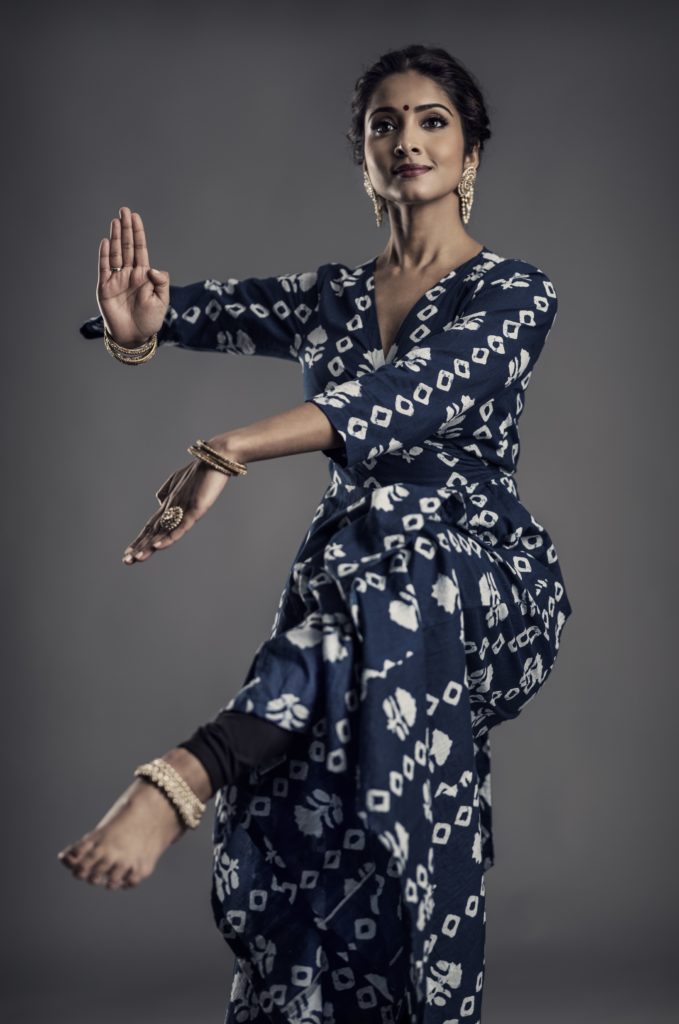
Revisiting Aladdin
“When Aladdin came back last fall after 18 months of shutdown, there was an openness to revisiting parts of the script and choreography that were no longer sitting as well as they did in 2014. With Disney’s blessing, I was able to tweak some Bollywood-based movements and hand gestures, or mudras, in a workshop with the entire company. What was a closed, squeezed gesture is now the alapadma mudra: a beautifully curved gesture of the hand that mimics the petals of a lotus.”
Staying Grounded
“I still take a ballet barre daily because it’s great conditioning that aligns me really well. Afterwards, I feel warm and my joints are lubricated, but I’m not so depleted that I can’t do the show.”
“I stay plugged in to bharatanatyam by teaching middle- and high-school students over Zoom. And I’m constantly choreographing and performing Bollywood dances for various weddings, which is so much fun.”
Playing the Violin on Broadway
“I never could have anticipated that in my Broadway debut—Natasha, Pierre & the Great Comet of 1812—I’d have to play a violin solo. There’s something to be said for maintaining skills that you’re passionate about. It doesn’t hurt to keep in touch with all the facets of your artistic background.”
The post Shoba Narayan is Bringing Bharatanatyam to Broadway and Beyond appeared first on Dance Magazine.

by Admin
The Pandemic Isn’t Over (and Maybe Won’t End?), but Yes, We’re Gonna Dance. Here’s How.
When COVID-19 smacked the world in the face during spring 2020, pushing a premiere of a new work three years ahead seemed sensible, responsive and strategic. It felt like if we just wait it out long enough, we’ll be able to do what we used […]
ran-&-raveWhen COVID-19 smacked the world in the face during spring 2020, pushing a premiere of a new work three years ahead seemed sensible, responsive and strategic. It felt like if we just wait it out long enough, we’ll be able to do what we used to do. Now, we are fully into Season 3 of the pandemic, and COVID continues to be regarded as an inconvenience to how we have always lived our lives. As I have asked myself and my collaborators the question “How are we gonna dance again?,” we at my collective, SLMDances, have taken the ongoing public health crisis as a call to action to fundamentally reconsider our behaviors for the care of ourselves and all those we come into contact with.
As a small budget organization that has largely self-produced its creative and community work, no one is dictating to SLMDances whether or not we have to wear masks or get tested. Protocols from various studios, performance spaces and event producers are inconsistent; as an individual freelance performer, I find myself frustrated by invitations into rehearsal and performance processes that don’t offer any kind of health, needs and accessibility check-ins right away for participants. Not to mention that COVID protocols for public events and indoor spaces can be hidden on websites, or just vaguely named as “COVID-safe,” as if we have actually come to a unified medical and legal agreement on what that means. It’s as if there is still no pandemic at all. As if almost 1 million people haven’t died in the U.S. alone, and millions more have not been infected and perhaps will never fully recover.
Since 2020, I’ve observed how others restart their creative processes: asking questions, collecting COVID-protocol documentation, and generally learning from others’ trial and error, all the while remaining virtual in my own creative practice. With an eye toward restarting an in-person creative practice in February 2022, SLMDances started check-ins with our collaborators last summer about vaccination status, testing frequency and accessibility, and any other needs with regard to health and safety.
We were lucky that one of our Creative Partners had experience tracking CDC guidelines and building COVID-protocol as a part of her role at a local New York City dance studio and was willing to do that work with us. She titled her role “Health Accountability Partner” and, based on our group conversations in relationship to city, state and federal guidelines, drafted a protocol that we collectively reviewed and agreed upon in order to begin in-person rehearsals.
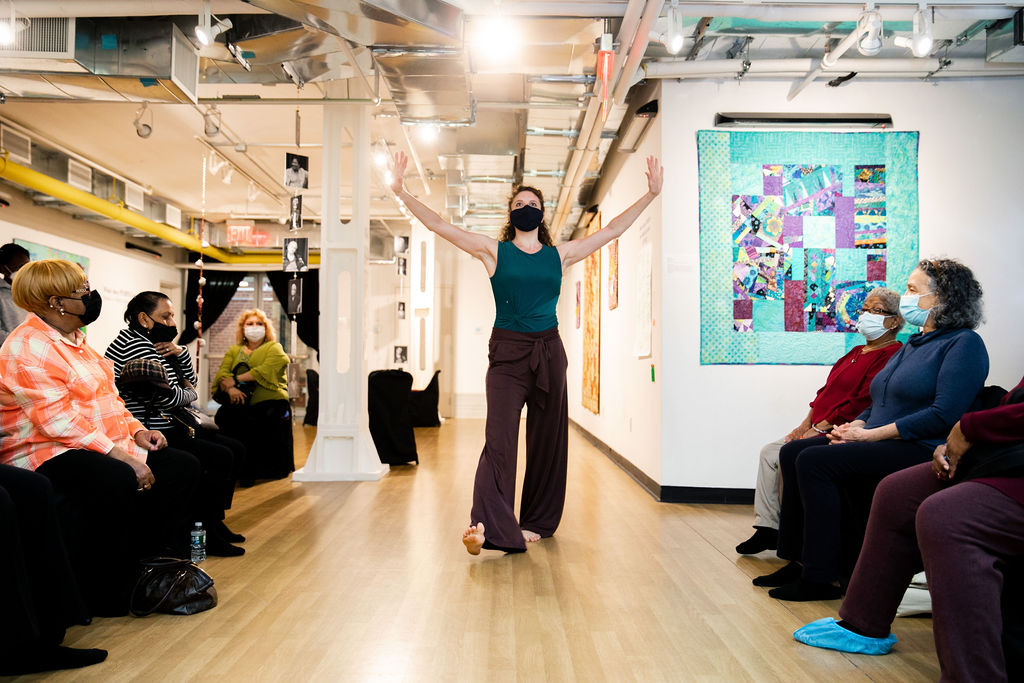
As a first step back into a studio practice, here is what we devised: Our twice-weekly virtual rehearsal became a shortened virtual rehearsal one day, and an extended in-person rehearsal on our second day to maximize our time together. Everyone in attendance must be vaccinated, get a PCR test within 72 hours of the in-person rehearsals and wear medical-grade masks. If a person has had a lot of exposure to the public, we ask them to also take a rapid test. In addition to a daily health survey for contact-tracing protocols, we check in at the top of each rehearsal about our comfort with physical touch and distance. We maintain a virtual rehearsal room during in-person rehearsals for creative collaborators who are not local, are sick with or have been exposed to COVID, or for any other reason that prevents in-person attendance.
Our strategy for a deeper studio practice toward getting our work to stage in 2023 is to do so in a series of creative “bubble” residencies where we can spend time together without the threat of the virus that might be transmitted in our daily commutes in New York City. And as we moved through our first pandemic performance this spring, we have tended to the roles of understudies with more rigor, preparation and care than ever.
As SLMDances talks about our approach to collective care and COVID protocols, I’ve encouraged artists to release the descriptive language of “strict,” which might connote what can’t be done or being denied something. Instead, we use phrases such as “abundance of caution” or “abundance of care.” We know that we are taking a risk when we come together and our protocols not only protect one another in the studio as much as possible, but also extend as much protection as we can to the most vulnerable in our communities, including immunocompromised folks, elders and young children who can’t yet be vaccinated. We know that what is allowed legally, what an individual feels comfortable with and the actual calculated risks that a person takes in order to attend to whatever is essential in their own lives does not equal what is actually scientifically safest. And so, we stay in dialogue and continue to check in on a consistent basis, setting our own internal community standards for shifting protocols despite the fluctuations in external COVID mandates. Our collective responsibility to keep one another safe has been handled by each Creative Partner with a beautiful integrity. I hold so much gratitude for my creative collaborators.
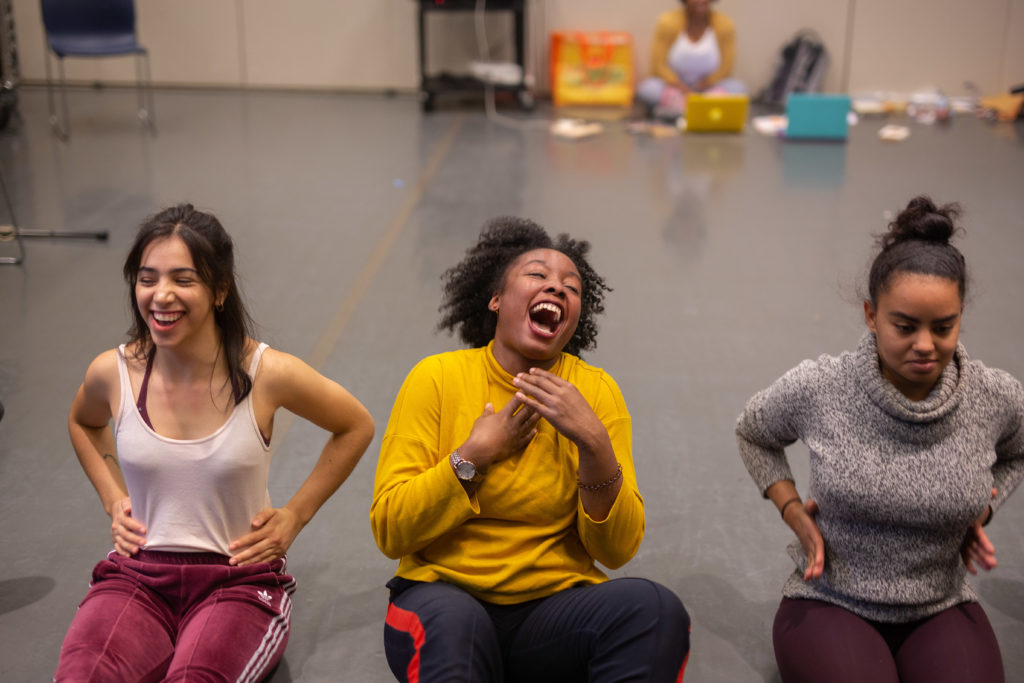
The true challenges we continue to meet happen outside our collective. Based on my experiences and observations in the pandemic thus far, here are some further behavior shifts that may protect the most vulnerable in our field seeking the safest possible return to an in-person practice:
Lead artists: Normalize stating your COVID protocols in the first communication to hire or collaborate with people, and then stay in dialogue about their health and safety needs. This frees potential collaborators from making decisions based on partial information, or searching for what they need to make an informed decision. This means that your COVID considerations cannot be an afterthought.
Venues and presenters: Communicate early and often to artists and audiences. Normalize publicly stating your COVID protocols and policies, and continuing to publicly update them. For performances, make information readily and easily available on websites and social media, and at the point of purchase. These actions allow people to more easily discern personal risk.
Funders: Build ongoing resources into your infrastructures to support COVID safety. Who gets to dance safely, with the lowest possible COVID risk, is a question of who has access to resources to ensure this safety. The fundamental nature of where and how we rehearse has shifted and funding must shift with it. Designate access to a significant amount of funded bubble-residency opportunities through lotteries or first come, first served sign-ups in order to ensure more COVID-safe opportunities to artists that are not curated.
I recognize that there is a significant level of privilege I have in being able to thoughtfully choose how to dance in person again. I am self-employed. I wield a multitude of skills, and while I do make money as a performer (and was counting on that income at the moment of the 2020 shutdown!), paying my bills has never been fully reliant on my being onstage.
I also recognize that if we don’t take the current moment to thoughtfully reimagine systems and structures for in-person creative practice and performance, a significant number of folks in our field will be left out.
The pandemic isn’t over just because we’re over it, the streets are calling, we’re vaccinated and mask mandates are easing. We must be intentional about navigating our new world, so that every artist who wants to dance can dance.
The post The Pandemic Isn’t Over (and Maybe Won’t End?), but Yes, We’re Gonna Dance. Here’s How. appeared first on Dance Magazine.
by Admin
Begin Again: Injuries—Gosh Dang It!
You know the clichéd question: If you could go back in time and tell your younger self one thing, what would it be? At the moment, I would very much like to go back eight months in time and beg that naive version of myself […]
ran-&-raveYou know the clichéd question: If you could go back in time and tell your younger self one thing, what would it be? At the moment, I would very much like to go back eight months in time and beg that naive version of myself to meet with a physical therapist before diving back into rigorous training. Maybe then I wouldn’t be dealing with an annoying (albeit relatively minor) toe injury that’s stalling some of my progress.
Alas, time travel has not been mastered just yet, and all I can do is share my experience with you. Hopefully you will all be wiser than me and return to your training (or continue it) hiccup-free.
The Situation
Back in October 2021, I started to feel a bit of irritation in my right big toe while on relevé. I only really noticed it while doing left en dehors pirouettes, balancing on my right foot or dancing in my LaDuca heels—and even then, it didn’t bother me too much. So I decided I’d write it off as a normal ache and pain that would go away on its own.
Spoiler alert: It did not go away on its own.
Fast-forward to February 2022: I began taking full ballet classes in my pointe shoes and finished each class with throbbing pain. My podiatrist took an X-ray and determined that the toe isn’t fractured (phew!), but thought that I might have tendinitis. Ice, rest and a cortisone shot did nothing to improve my pain, and he finally recommended that I see a physical therapist. Cue Heidi Green, the magical unicorn therapist in New York City who specializes in dancers. (She even worked as the therapist on the Lion King tour at one point!)
The Diagnosis
It didn’t take much time in Heidi’s office before she knew two things: One, there were many funky things happening in my body that she thought were contributing to my injury; and two, she wanted me to take some time off from relevé and jumps. Ugh.
When I asked her if I could have done anything differently to prevent this she said, “If someone is returning to dance after a long break, it is definitely ideal to get a screening or an evaluation by a PT to detect any potential imbalances or precursors to injury.” Of course, that won’t be financially realistic for many people—frankly, I would have put myself in that camp. But I got injured and was forced to go to PT anyway, so I suppose it’s sixes in the end.
The second thing we all know I could have done differently? Say it with me now!
“GET TREATMENT AS SOON AS YOU FEEL UNUSUAL PAIN! WAITING FOR CARE ONLY EXTENDS THE RECOVERY PROCESS AND MAKES YOU FEEL SAD!”
The Treatment Plan
Though Heidi thinks it’s possible that I have tendinitis, she also thinks there are likely a variety of problems that could be contributing to the problem. Therefore, she is looking at my body holistically and recommending treatments that go beyond my right foot.
Once a week for the foreseeable future, Heidi wants me to go into her office for a variety of assessments and treatments, including soft-tissue mobilization, joint mobilization, asymmetry corrections and strength training. “Anywhere up the chain of that leg that’s injured, I’m working to correct those asymmetries,” she says.
Between visits, she gives me homework. So far that includes massage, TheraBand foot exercises, weightless relevés (I sit in a chair with my feet on the ground and a ball between my knees while I raise and lower my heels), clamshells (an exercise where you lie on your side in the fetal position and open and close your top leg) and icing my toe.
The Bad News
Heidi doesn’t want me jumping until my toe feels better. Which makes me spiral into an everlasting pit of darkness because I’ve already spent 10 years off of dancing, and any additional time feels like an eternity. Too much? All right, I will tone down the drama.
Hopefully, addressing and treating the challenges within my entire body will make me a stronger dancer as well as help heal my toe, and it will all be worth it in the end. Everything happens for a reason, right? Man, I hope so!
The post Begin Again: Injuries—Gosh Dang It! appeared first on Dance Magazine.

by Admin
Fuel Your Body For Dance!
Eating right can help you make the most of your ballroom dancing lesson at Fred Astaire Dance Studios as you improve your dance moves! Ballroom dancing is a fun way to stay active and trim your waistline. Thirty minutes on the dance floor can burn […]
Ballroom dancesEating right can help you make the most of your ballroom dancing lesson at Fred Astaire Dance Studios as you improve your dance moves!
Ballroom dancing is a fun way to stay active and trim your waistline. Thirty minutes on the dance floor can burn at least 200 calories. That’s more than 30 minutes on the elliptical or rowing machine. Ballroom dancing is an ideal form of exercise you can do year-round from the comfort of your living room or in the fun atmosphere of one of our local studios. Fred Astaire Dance Studios helps you improve your dance moves by offering private and group lessons at our local studios, as well as Online Lessons you can live-stream at home.
Nearly 60% of adults in the United States suffer from a diet-related chronic condition, such as type 2 diabetes or cardiovascular disease. Unhealthy food choices may lead to obesity, which raises the risk for heart attack, cancer, and sleep disorders. The United States Department of Agriculture recommends adults limit eating foods high in added sugar, saturated fat, and sodium. They advise eating a diet rich in nutrient-based foods, including vegetables, fruit, and whole grains. Experts urge men to target 2,500 calories per day, and for women, 2,000.
Eat Your Vegetables
Dancing can help you get fit, but to ensure you’re ready to get groovy, it’s important to fuel up by making healthy choices. Consuming a healthy diet and making sure to eat the right amount of calories can make you a better dancer.
Stem Muscle Fatigue
Complex carbohydrates from whole grains, beans, and starchy vegetables break down into glucose, which provides your muscles with fuel to give you the energy to perform at a high level for the duration of your lesson.
Prevent Injury
Healthy proteins, like chicken, fish, and turkey, strengthen muscle tissue and decrease the chances of suffering a strain during a high-energy dance, like the salsa or swing.
Strengthen Bones
A common problem, particularly among seniors, is bone loss. Eating calcium-rich foods can help strengthen bones and increase your range of motion while dancing.
Making sure to stay properly hydrated should also be part of your healthy eating plan. Drinking water can help improve your heart health and kidney function. Staying hydrated can also boost metabolism and help lose weight.
by Admin
Caleb Teicher on Choosing Dance After the Pandemic
Why do I dance? I never really asked myself that question. My initial love for dance was visceral and complete; when I started as a teenager, my brain and body had found an activity that could consume my thoughts and my schedule, and I accepted […]
ran-&-raveWhy do I dance? I never really asked myself that question. My initial love for dance was visceral and complete; when I started as a teenager, my brain and body had found an activity that could consume my thoughts and my schedule, and I accepted that with joy. At 17, when I moved to New York City to pursue a career in dance, it became my professional identity and my purpose.
But the pandemic put so many roadblocks on that life. Locked down in my apartment, I couldn’t tap dance (too loud), and I couldn’t swing dance (no partner). There were no social dances to attend, no in-person classes to teach or take, and there certainly were no gigs that obligated me to “be” a dancer. There were very few occasions where I even felt like dancing, and so, for the first time, I didn’t.
I did other things: I played piano. I biked around New York City. I read 30 books that had sat in my home for years. I was surprised to feel satisfied by these dance-less days. Without dance, I still felt like me.
But when the world “reopened,” I returned to my usual routine of performances, dance festivals and work meetings. I was ready to do something, and work (miraculously) came back. I was eager to reconnect with my chosen family of artistic collaborators, and I was excited to become, again, a dancer.
“Dance is the lens through which I experience everything else.”
Caleb Teicher
But something has changed. I feel different—I don’t feel like the dance-obsessed pre-pandemic version of myself. My new self loves dance, but my new self also loves biking, reading and playing piano.
My first ballet teacher said to me, “Dance is a sickness of sorts. It’s not something you choose to do; it’s something you must do.” I used to agree. But now, it feels like something I choose to do, and I like that.
The decision to dance has been, and continues to be, so good for me. I’m glad I have dance; it’s the constant. It’s the lens through which I experience everything else. It’s simply the most interesting thing I’ve ever chosen to do.
The post Caleb Teicher on Choosing Dance After the Pandemic appeared first on Dance Magazine.
